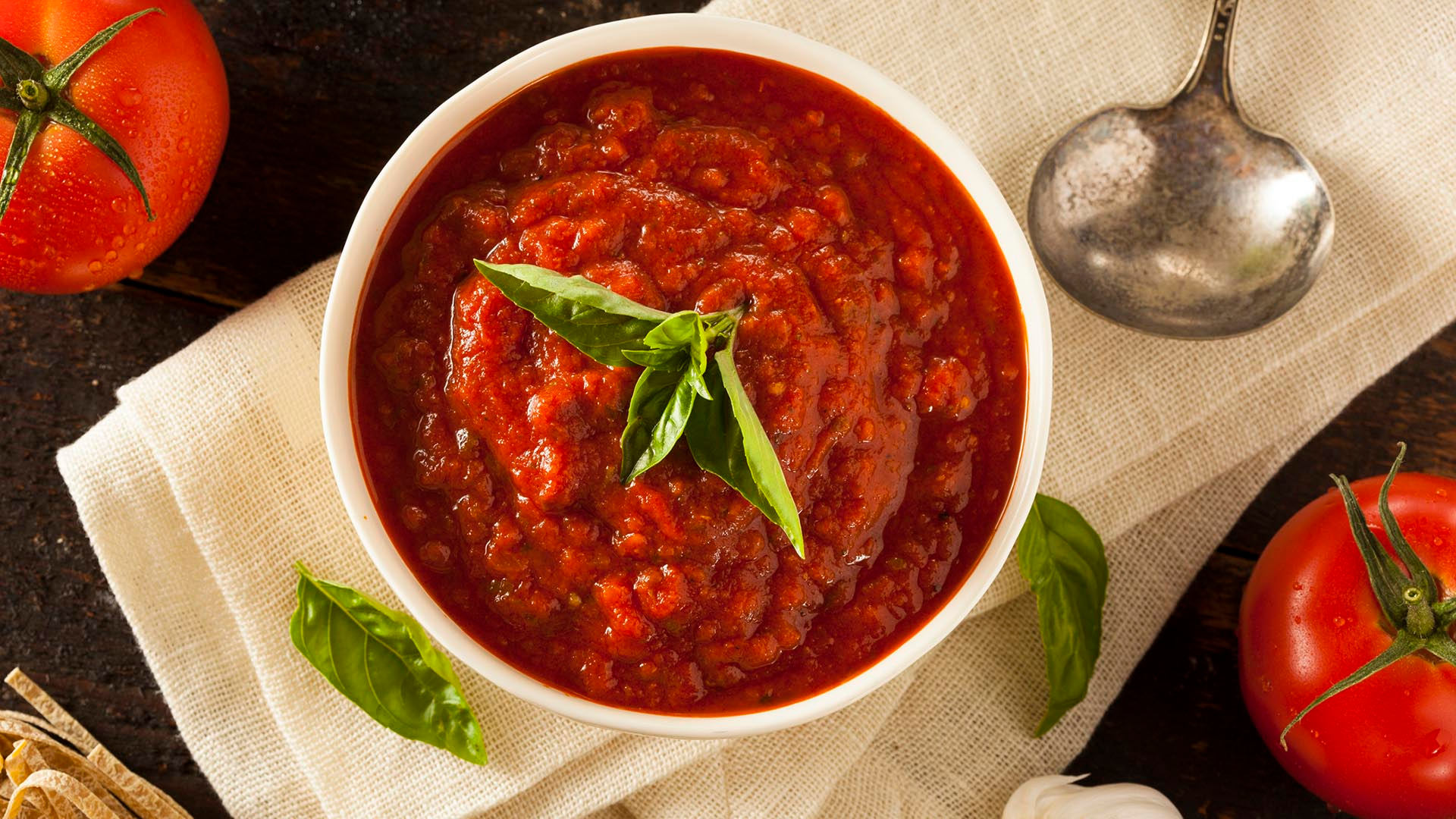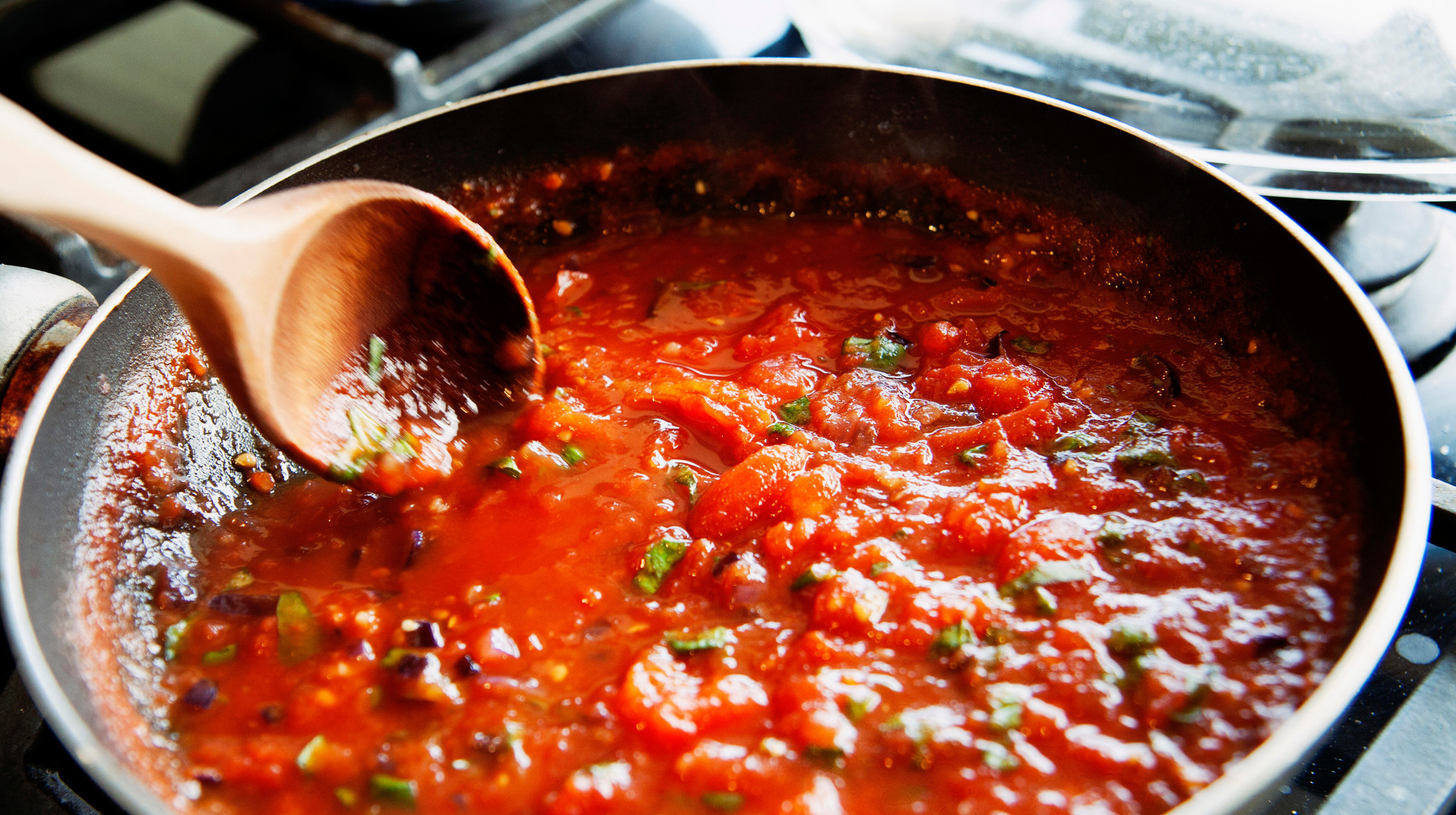Tomato, Tomahto: Why You Need 2 Marinara Recipes In Your Repertoire
Last week's jarred tomato sauce taste test taught me that our readers fall squarely into three camps:
- People who really want me to try Rao's jarred sauce
- People who want to tell me about the famous Marcella Hazan sauce
- People who have never made a simple tomato sauce, but would like to learn
- Yes, I've tried Rao's tomato sauce. I've even eaten at Rao's, and I can tell you their sauce is very similar to my weekend sauce.
- I've also tried Marcella's, and I make a variation of it for my weeknight sauce.
- I'm going to tell you how to make both of them, so you'll know how to make your own tomato sauce.
This is a fantastic spread of people because, for the first time ever, I may actually succeed in making everybody happy! So to all of you out there:
See? Everyone is about to be a winner!
The obvious question: Why do I have two tomato sauce recipes? It all comes down to timing. The classic Italian-American red sauce I grew up with takes a long to make, letting it barely simmer and reduce ever so slowly, allowing some of the tomatoes' sugars to caramelize, creating a depth of flavor that, no matter what the internet may tell you, cannot be replicated with a food hack. I used to make large pots of this on a regular basis, keeping in stored in quart containers in my freezer, but I'd inevitably have that night where I discovered too late that I'd depleted my stash. You can't begin to imagine the heartbreak.
Then around 10 years ago, I discovered the miraculous Marcella Hazan sauce. It's not only quick to come together, but spectacularly delicious in a way my long-simmered sauce wasn't. There were no notes of caramel, no deeply concentrated tomato flavor, no pungent garlic, or slick streak of olive oil. The Marcella sauce was lighter, creamier, and full of brightness. It wasn't that it was a better sauce—it was just different than what I'd long been used to. I liked them both, and decided there was room for two different sauces in my kitchen.
Everyone who makes the Marcella sauce instantly becomes an evangelist for it, not only because it tastes incredible, but also because it's so simple to make it seems way too good to be true. You don't even need decent knife skills to make it: Pour crushed tomatoes into a pot, add quite a bit of butter, then cut a whole peeled onion down the middle and toss it in. Simmer the whole thing together for about half an hour or so, remove and toss the onion, and you've got exceptional tomato sauce. It seems impossible that something so simple could taste so good, but somehow, it does. It's a miracle of a recipe.
My weekend "Rao's-style" sauce is a bit more complex. It involves finely mincing garlic and onions, and slowly cooking them in glugs of olive oil until they're shimmering like molten gold. It requires breaking down the tomatoes by hand, removing the seeds and fibrous cores without discarding the bulk of the tomato flesh. It takes a low flame, plenty of stirring, and lots of time and patience.
Also important: your ingredients. Many people swear that to make a good sauce, you must only use San Marzano tomatoes, but that's a lie. I mean that literally—95% of the "San Marzano tomatoes" in the U.S. are what we in the old neighborhood called fugazis. If you want the real ones, you need to develop a relationship with your local importer who can swear on his St. Anthony medallion that he's getting you the good stuff. Since I moved out of Brooklyn I no longer have "a guy," but I've found that Muir Glen makes an excellent canned tomato that's just as good, if not better, than San Marzanos. But honestly, the brand you go with completely up to you. Don't let anyone shame your tomato choices. I make sauce with the generic tomatoes at Aldi pretty regularly and it still tastes spectacular.
That's one of the most lovely things about tomato sauce—there's no "right" way to make it. Every family is supposed to have their own secret recipe, everyone is supposed to claim theirs is "the best." That means you're meant to take these basic instructions and, once you're comfortable enough with the process, go off and have your way with it all. Add a splash of red wine, a pinch of sugar, a touch of oregano, a handful of basil, a liberal sprinkling of crushed red pepper flake. As long as you like it, it's all good.

Weeknight Tomato Sauce
- 2 (16-oz.) cans crushed tomatoes—whatever you've got
- 2-12 cloves of garlic (When you're adding garlic to something, you don't follow a recipe—you follow your heart.)
- 3/4 stick of butter, salted or unsalted—just adjust your seasoning later
- 1-2 Tbsp. olive oil. I've never measured this amount. Just give it a good glug
- 1 medium onion, peeled and cut in half through the middle. Yes, you can leave that little stubby bit at the bottom.
In a large saucepan over medium heat, melt the butter with the olive oil. Smash the garlic cloves with the side of a knife or your favorite whacking stick, then throw them in the pot and cook until golden. Add the tomatoes and onion, give it a good stir, and reduce the heat to medium-low. Cook for half an hour, stirring occasionally. Give it a little taste, and add salt accordingly. Pull out the onion and whole garlic cloves, and put them aside on a small plate. The traditional Marcella recipe says to simply discard the onion, but I like bringing it (and the garlic) to the table to smear all over crusty bread.
Weekend Tomato Sauce
- 4 cans whole peeled tomatoes
- At least 6 large cloves of garlic—more if you want; no one can stop you.
- 1 large or 2 small onions, very finely diced
- 1 small carrot, peeled and microplaned into the finest of fine shreds
- A whole lot of olive oil—enough to coat the bottom of your pot
First, set a fine mesh strainer over a bowl. Put the tomatoes in the strainer, one at a time, and break them apart roughly with your hands. Remove the cores and as many seeds as you can, then dump whatever's left into the bowl below. Once you're done, rinse out each of the tomato cans with 1/2 cup of water, then add to the tomatoes. Hot tip: Keep one of the cans around to use as a spoon rest. You're going to be doing a lot of stirring.
Get yourself a big sauce pot and cover the bottom with a thin coat of olive oil, then set it over medium heat. Add the onion, carrot, and a hefty pinch of salt. Cook until golden, about 5 minutes. If you like things with a bit of a kick, this would also be when you'd add a bit of crushed red pepper or Calabrian chili. It's not essential, though, so don't feel bad if you leave it out.
Mince your garlic as fine as you can—I find garlic presses worthless, but love a Microplane if you're not yet great with a knife. Throw it in the pot and cook while stirring until it just begins to turn golden, then take the pan off the heat.
Put a heat diffuser on the burner, then put the pan back on. If you don't have a heat diffuser, you should buy one. I'd even go as far as saying it's the "secret ingredient" to most of the great sauces you've had in your life. The next few hours will be where the magic happens.
Add the tomatoes, turn the heat to high, and bring to a near boil, stirring every few minutes. Reduce the heat to medium low and simmer, gently stirring every 10 minutes, for at least an hour. Once that hour is up, then you can taste with the intent of making adjustments. If it's a little acidic, add a pinch of baking soda or sugar, or a few pats of butter. If it's bland, add salt. If you're so inclined, add a bunch of fresh, torn up basil. And if it's not as intense as you want it, just keep simmering and stirring.
Personally, I like my sauce cooked for a minimum of 90 minutes. When I make gravy—which is sauce with a bunch of different meats thrown in—I can let that pot go for two, three hours. What's important here is that you stay on top of the sauce, tasting every so often, taking your own notes, and turning off the heat when you've reached your personal ideal. Then you can write it on the back of a piece of errant junk mail and pass it down for generations, just as every Italian grandma has done for centuries.

